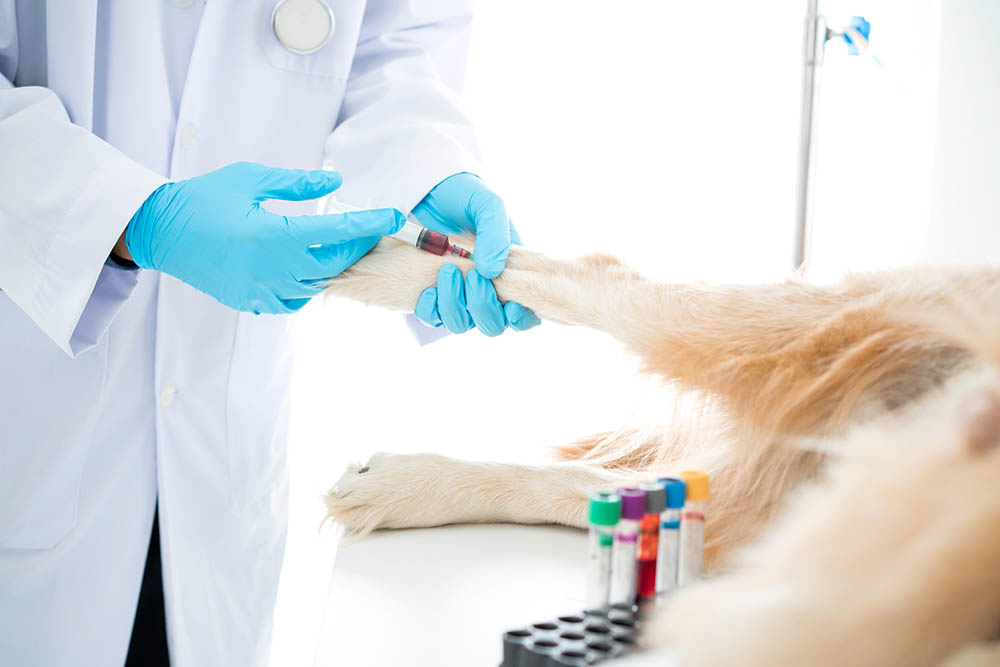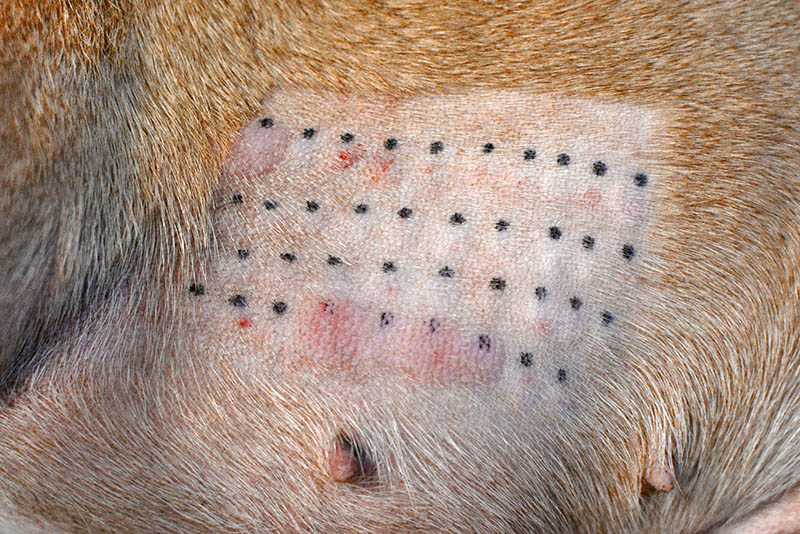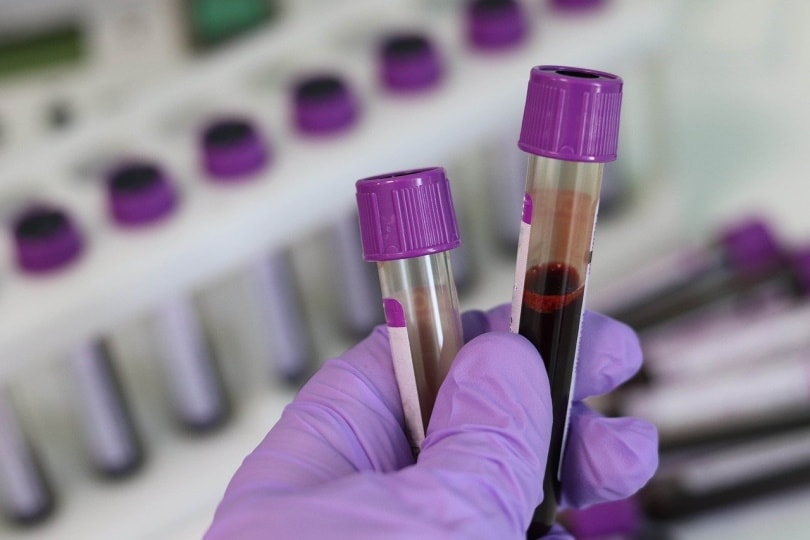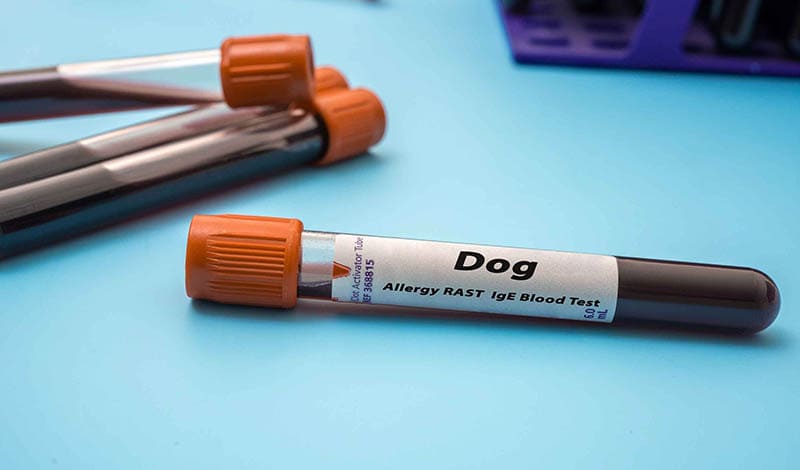In this article
View 5 More +Dogs are often allergic to certain things in their environment and react to substances at a specific level of exposure. Dog allergy testing is a useful tool for veterinarians to determine which substances are causing your dog to react. Allergy testing assesses your pet’s immune system response to common allergens they will encounter every day. This includes substances such as dust mites, grasses, pollens, mold spores, flea or mite saliva, and food.
This article will discuss, in-depth, the ways vets can test for allergies in general practice. If you are concerned that your dog has an allergy, book an appointment with your vet so they can begin investigations.

How Does It Work?
Both the serological blood test and the intradermal skin testing (discussed below) work by measuring the IgE antibody.1 The difference is that intradermal skin testing measures the allergen-specific IgE that is bound to mast cells, whereas the blood test measures the amount of IgE in the circulating blood. IgE refers to immunoglobulin E. These are antibodies produced by the immune system. If your dog is allergic to something, when they are exposed to the substance, their body overreacts by producing too much of the IgE. The antibodies cause cells to release unwanted chemicals that cause an adverse reaction. Therefore, if they are present in your dog’s skin or blood, this means the dog has reacted to something.
There are sometimes differences between the results of the two tests. If finances permit, some dermatologist vets will do both tests alongside each other as there seem to be more reliable results this way.
What Are the Different Types of Allergy Testing?
There are currently two main types of allergy testing available. These are serological blood testing, and intradermal skin testing. They can both be useful in the diagnosis of allergies however they work in very different ways, and both have pros and cons.
Serological (Blood) Testing

This is a test carried out from a blood sample taken from your dog. The blood sample is analyzed for specific antibodies called IgE that indicate your dog is allergic and will react to certain allergens. These allergens are usually known to cause allergic clinical signs. This is a quick, easy test (providing your dog tolerates their blood being sampled) and is useful in identifying what your dog may be reacting to. It does have its limitations though, and is not thought to be as accurate as intradermal skin testing.
Serological testing generally tends to be easier and quicker than intradermal testing. The downsides are that it is usually only carried out by a veterinary dermatologist, and depending on your location, this may be a long journey. The costs can be high too. Unless your dog is very placid, sedation is usually required, which also adds to the cost. Medication can affect the results of both tests, so any medicine must be stopped prior to the test being taken. The type of medication used depends on how long it needs to be stopped. Your vet will be able to guide you.
Intradermal Skin Testing

Intradermal skin testing involves clipping away a patch of hair to expose your dog’s skin, and then injecting a number of known allergens in small quantities. Two control solutions are also used to compare the different reactions. The positive control is histamine—there will always be a reaction to this. The negative control is the solution in which the allergens are contained, and there should not be a reaction to this. The skin is closely observed over a time period of 15–20 minutes to assess if any reactions are witnessed.
If your dog is allergic to the substances they have been exposed to, a small hive will form at the injection site. This is called an erythematous wheel. The hive can be measured to assess the severity of the reaction. The size of the hives is compared to the size of the hives made by the control solutions. This allows the vet to determine which allergens make the dog react.
This type of testing is thought to be the gold standard of dog allergy testing, but your dog will usually require sedation for the procedure. Intradermal skin testing is useful in identifying a large number of different potential allergens rapidly. It is performed in one visit and is relatively non-invasive. The downsides are that unless your dog is extremely placid, it will require sedation or general anesthetic to be carried out properly, and only an experienced vet or vet dermatologist will be able to process and interpret the results. Medications that your dog may be on will need to be stopped prior to testing. Depending on how bad the allergic reaction is, this may cause considerable discomfort if medication such as steroids or antibiotics are stopped.

Which Allergy Test is Best?
Both serological blood testing and intradermal skin testing have their place. For a lot of dogs, the results are the same whether blood testing or skin testing has been carried out. However, for some dogs, one or the other test identifies more allergens. This does seem to depend on the individual. It is impossible to know prior to testing, which test will suit which dog. A lot of the time, both tests are carried out (if finances permit) and this gives the most comprehensive guide to the allergens for the dog. There is no “perfect” allergy test and some dogs who have clinically severe itching will have no positive results on either test. If your vet suspects your dog may be suffering from food allergies, a food elimination diet is recommended as opposed to blood or skin testing.
A vet will be able to advise you on the best course of action to ensure the well-being of your pet.
If you need to speak with a vet but can't get to one, head over to PangoVet. It's our online service where you can talk to a vet online and get the advice you need for your dog — all at an affordable price!

Where Is It Used?
Allergy testing will be used in any instance where a dog is showing signs of allergies. Allergies are very common in dogs. If you are concerned your dog is suffering from allergies, you should contact your vet for a consultation. Your vet will arrange allergy testing after examining your dog and taking a full clinical history if they deem it necessary. Common indications of allergies include:
- Itching/biting at skin
- Chewing paws
- Skin rashes/ inflamed skin
- Sore patches of skin, especially paws, stomach, face, and ears
- Alopecia (fur loss)
- Brown saliva, staining of the skin
- Itching eyes or rubbing them on objects
- Nasal discharge
- Cough
- Vomiting
- Diarrhea
- Behavioral changes
Dog allergy testing is used to identify the underlying cause of the allergy signs.
It can also help to diagnose atopic dermatitis, which is a chronic, inflammatory skin disease closely associated with allergies. Before atopy is diagnosed, it is important to rule out things like skin infections, parasites, and viruses. When used to diagnose atopic dermatitis, allergy testing is a useful aid in directing immunotherapy treatments.
When your vet is investigating potential allergens for your dog, they are likely to suggest carrying out a food elimination diet trial too. Usually, this involves feeding a novel protein diet or a hypoallergenic diet made up of hydrolyzed protein. With hydrolyzed protein diets, due to the way the food is processed, the protein is broken down into very small particles so the body doesn’t recognize them as the offending protein.
This diet will be fed for a specified period of time, after which normal foods will start to be re-introduced one by one. The dog is closely monitored for a reaction after each food type is reintroduced.
Blood testing and intradermal skin testing can be used for food allergy testing; however, they are not thought to be very accurate, and food elimination trials are recommended over other tests for accuracy.
How Are the Results Used?
The reason vets carry out these tests on dogs is to identify the allergens that are causing an adverse reaction for that individual dog. With this information, they can make a serum using these allergens. The serum is given to the dog to desensitize them to their allergy triggers. This is called Allergen Specific Immunotherapy. It is done on an individual basis for each dog based on their test results.
The serum is usually made into an injectable solution that is administered with a specific schedule. It is also possible to make an oral solution that is given by a dropper under the tongue. This is a good option for dogs that don’t tolerate injections well. Some owners will administer the therapy at home, while others will need to go to the vets for injections.


Frequently Asked Questions
At what age should allergy testing be carried out?
Allergy testing can be carried out from 6 months of age, although most veterinarians recommend waiting until your dog is at least 1 year old. One of the reasons they may decide to do it earlier is if there is a severe disease that needs appropriate treatment imminently.
What are the most common allergies in dogs?
The most commonly seen allergy in dogs is the flea allergy. Other allergens often seen include house dust mites, molds, food products, insects, and pollens from grasses and trees. Many dogs suffer from a combination of flea, food, and environmental allergies.
Which dog breeds have the worst allergies?
All dogs can experience allergies, and they can develop at any age. The more common breeds affected include West Highland White Terriers, French Bulldogs, Shar Peis, Golden Retrievers, Labrador Retrievers, Shih Tzus, and Boxers.
How are food allergies diagnosed in dogs?
The most reliable way to test for food allergies in dogs is a food elimination diet trial. Intradermal skin testing and serological blood can be used but are not thought to be as reliable or accurate.

Are at-home allergy test kits reliable?
At-home allergy test kits are not thought to be reliable. These tests usually involve taking samples of hair or saliva from your dog. Most of the tests available to the general public are not validated and not vet-approved. There is no guarantee they have been tested against allergens and they don’t hold any long-term solutions for allergy management.
Will any medication affect the test results?
There are a few medications commonly used that will affect allergy testing results due to their systemic effect on the body. These include:
| Injectable steroids: | Recommended to be discontinued for 8–12 weeks before testing |
| Antihistamines: | Recommended to be discontinued for 10–14 days before testing |
| Oral Steroids: | Recommended to be discontinued for 4 weeks before testing |
| Topical Steroids: | Recommended to be discontinued for 4 weeks before testing |
| Fish Oils/fatty Acid Supplements: | Recommended to be discontinued for 10–14 days before testing. |
Your vet will give you strict instructions on what needs to be done prior to the testing.
What are the benefits of allergy testing?
The benefits of allergy testing are being able to pinpoint the exact allergens that are making the dog react and enable your vet to use targeted allergy treatment. Currently, the only curative form of treatment is immunotherapy. Allergy testing allows for immunotherapy to be tailored to suit your dog’s individual needs. It works to desensitize your dog to allergens and reduce and eventually eliminate the clinical signs seen.

Final Thoughts
Allergy testing is a valuable tool to diagnose allergies and enable your vet to make a tailored treatment plan. Allowing your vet to use immunotherapy to tackle your dog’s allergies is the only curative treatment for dogs. Immunotherapy works by gradually desensitizing your dog to the allergens they are allergic to.
Allergy testing for dogs is done by either intradermal skin testing or serological blood testing. There are advantages and disadvantages to both methods, and your vet will be able to advise you on which is more suitable for your individual dog.
Featured Image Credit: luchschenF, Shutterstock



















2 Responses
My six year old dog , started last year & Zertec worked very well, this year his allergy are terrible always start a in August & this year they are still continuing to chew on his paws & lick . Have noticed a little change in personality, he has been too the vet several times and they still can’t help us been bathing him and wash his feet , if you have any suggestions please let me know .
Hi Mary,
I’m so sorry to hear your dog is having such a tough time with allergies, that can be really frustrating for both of you. It sounds like you’ve been doing a great job staying on top of things and working closely with your vet.
Since your pup’s symptoms have changed and he’s still uncomfortable, it’s definitely best to keep following up with your veterinarian and even ask about seeing a veterinary dermatologist. Allergies can be complex, and sometimes it takes a specialist to pinpoint triggers or adjust treatment. You can also consider booking an appointment with one of our expert vets at pangovet.com for an online consultation 🙂
Have a great day!